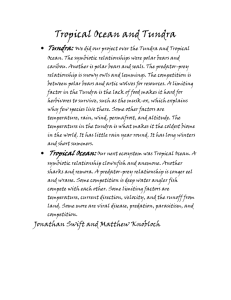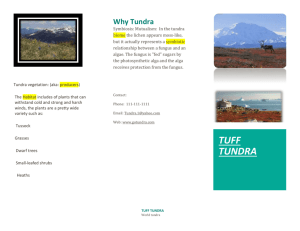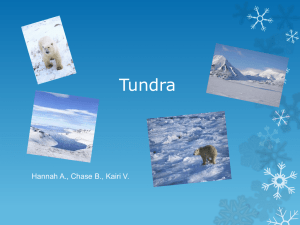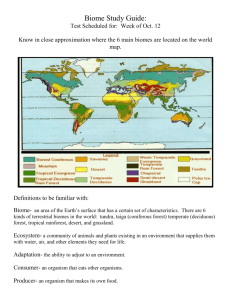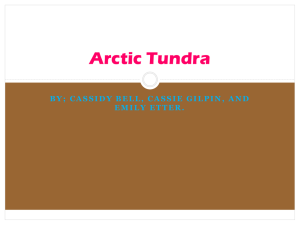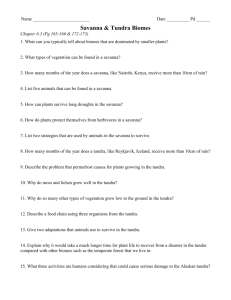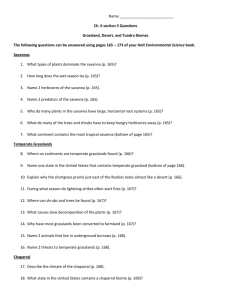Tundra - academicskills
advertisement
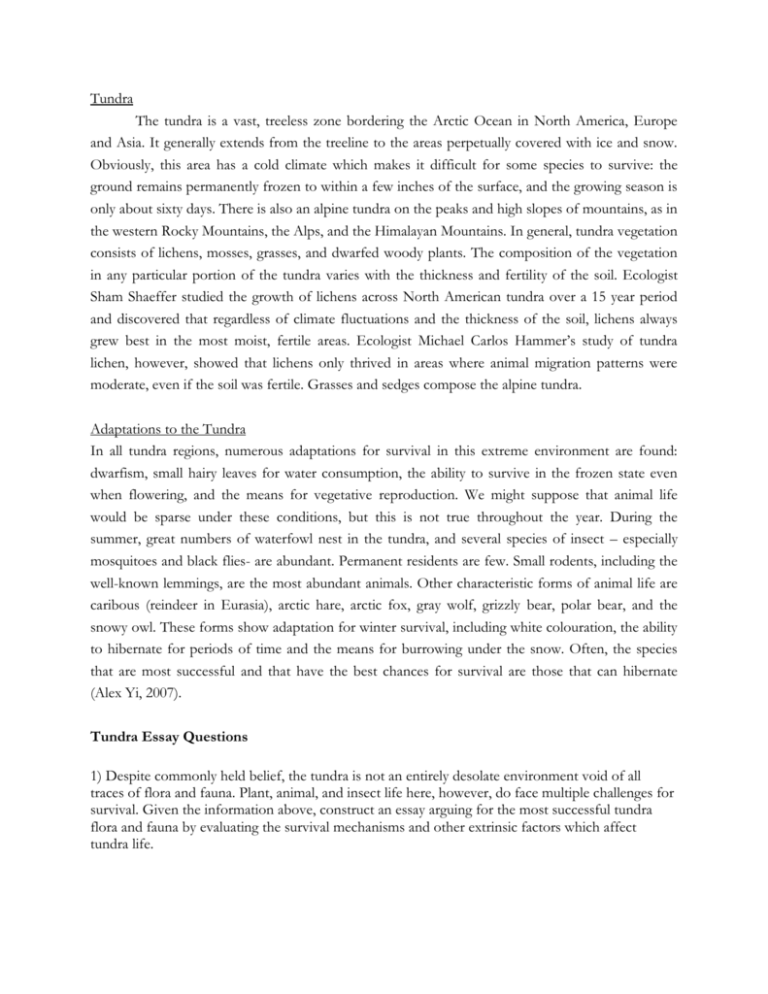
Tundra The tundra is a vast, treeless zone bordering the Arctic Ocean in North America, Europe and Asia. It generally extends from the treeline to the areas perpetually covered with ice and snow. Obviously, this area has a cold climate which makes it difficult for some species to survive: the ground remains permanently frozen to within a few inches of the surface, and the growing season is only about sixty days. There is also an alpine tundra on the peaks and high slopes of mountains, as in the western Rocky Mountains, the Alps, and the Himalayan Mountains. In general, tundra vegetation consists of lichens, mosses, grasses, and dwarfed woody plants. The composition of the vegetation in any particular portion of the tundra varies with the thickness and fertility of the soil. Ecologist Sham Shaeffer studied the growth of lichens across North American tundra over a 15 year period and discovered that regardless of climate fluctuations and the thickness of the soil, lichens always grew best in the most moist, fertile areas. Ecologist Michael Carlos Hammer’s study of tundra lichen, however, showed that lichens only thrived in areas where animal migration patterns were moderate, even if the soil was fertile. Grasses and sedges compose the alpine tundra. Adaptations to the Tundra In all tundra regions, numerous adaptations for survival in this extreme environment are found: dwarfism, small hairy leaves for water consumption, the ability to survive in the frozen state even when flowering, and the means for vegetative reproduction. We might suppose that animal life would be sparse under these conditions, but this is not true throughout the year. During the summer, great numbers of waterfowl nest in the tundra, and several species of insect – especially mosquitoes and black flies- are abundant. Permanent residents are few. Small rodents, including the well-known lemmings, are the most abundant animals. Other characteristic forms of animal life are caribous (reindeer in Eurasia), arctic hare, arctic fox, gray wolf, grizzly bear, polar bear, and the snowy owl. These forms show adaptation for winter survival, including white colouration, the ability to hibernate for periods of time and the means for burrowing under the snow. Often, the species that are most successful and that have the best chances for survival are those that can hibernate (Alex Yi, 2007). Tundra Essay Questions 1) Despite commonly held belief, the tundra is not an entirely desolate environment void of all traces of flora and fauna. Plant, animal, and insect life here, however, do face multiple challenges for survival. Given the information above, construct an essay arguing for the most successful tundra flora and fauna by evaluating the survival mechanisms and other extrinsic factors which affect tundra life. 2) Given the tundra’s permanently frozen soil and lack of permanent wildlife settlement, evaluate the claim: the tundra is the most difficult ecosystem in which to survive. In particular, please discuss the controversy over the success of tundra flora and the survival mechanisms of tundra fauna. 3) Much of tundra flora and fauna is on the brink of extinction. Many ecologists have concerted their efforts and intend to devise a plan that will help repopulate the tundra and increase the survival of its existing flora and fauna. Given the information above, construct a ‘tundra rescue’ plan of your own by discussing the factors which affect the success of tundra flora and the survival mechanisms of tundra fauna. 4) Ecologist Sham Shaeffer and M.C. Hammer ignited a heated academic debate over the conditions of survival for tundra flora. Given the information you know about tundra flora and fauna, evaluate each ecologist’s argument, taking a firm stand on which one you think is most persuasive. TIPS FOR TAKING TROUBLESOME (TUNDRA) TESTS Before you even begin writing: 1) Read each question, mentally making note of: a. the terms you are most familiar with b. the difficulty of the question c. how much information and knowledge immediately comes to mind on the question’s topic 2) Pick the question you feel that you can answer the most thoroughly and with the least difficulty. You’ve wisely picked a question if: a. you can understand the question b. if many pieces of information easily come to mind c. if you can quickly sketch out a potential thesis Answering the Question: 1) However annoying it sounds, “answer the question”!! Writing an essay that does not answer the essay question is like asking a professor when your term paper is due and getting a response that outlines the history and pedagogy behind why term papers are assigned. “Answering the question” means breaking down the components of the question and understanding what each part is asking you to answer. a. Circle key content terms (ie. The theorists, the terminology etc) b. Highlight key essay action words (ie. “compare”, “discuss”, “contrast” etc) 2) Looking at the structure of the essay question will guide how your essay response should flow. If the question mentions to “compare”, find the key terms in the question which need to be compared. If you know you need to write a comparison essay, one possible essay structure is the following: a. i) Topic, issue, or fact ie. Tundra survival mechanisms ii) what key term 1) says about I polar bears: what survival mechanisms they use iii) what key term 2) says about I arctic foxes: what survival mechanisms they use iv) which key term is most persuasive which animal, polar bear or arctic fox, is best suited to survive given its survival mechanisms. 3) A brief point by point outline is an effective way to keep your thoughts on track; by foregrounding the structure of your essay, inputting material becomes far easier when writing. Lacking a formal structure before you begin often leads to an incoherent flow of writing—you begin writing one thing, which leads to another loosely linked point, and by the end of it, the paper ends up a jumble of thoughts rather than a coherent argument. It’s like a human body without a skeleton: all the pieces are there, but the human becomes an unrecognizable lump because there is no underlying structure keeping all its component limbs in their correct place. 4) Use evidence to support your arguments! Your arguments are only opinions if you have no STUDY or other EMPIRICAL EVIDENCE to substantiate your claim! You wouldn’t buy a car just because a car dealer tells you it’s a ‘beaut’. You’d need to know what features make it a ‘beaut’ before you shell out your dough. It’s the same for buying the argument you make in your essay test -- statements without any empirical evidence to support them just won’t sell your essay. 5) Leave time for revision if at all possible. These extra 3-5 minutes allow you to scan your work, add in a few interesting points, and change silly mistakes like missing a “not”. You’ll be surprised how much you can catch. Style Tips: 1) For the purposes of an essay test, your knowledge is only as valuable as your ability to communicate it. Use clear and precise words to help you get your point across. There is no point in getting your thoughts jumbled in hyperbolic, ornate, flowery or ostentatious diction (see, even reading these 4 adjectives is tedious—imagine how your TA feels when reading 89 papers all in this same indirect style!) 3) Much of tundra flora and fauna is on the brink of extinction. Many ecologists have concerted their efforts and intend to devise a plan that will help repopulate the tundra and increase the survival of its existing flora and fauna. Given the information above, construct a ‘tundra rescue’ plan of your own by discussing the factors which affect the success of tundra flora and the survival mechanisms of tundra fauna. Steps to writing a well-organized essay 1) Break down the question: what is the question asking you to answer? After severe ecological damage, much of tundra flora and fauna is on the brink of extinction. Many ecologists have concerted their efforts and intend to devise a plan that will help repopulate the tundra and increase the survival of its existing flora and fauna. Given the information above, construct a ‘tundra rescue’ plan of your own by discussing the factors which affect the success of tundra flora and the survival mechanisms of tundra fauna. The question is asking you to pose a plan that would “help repopulate the tundra and increase the survival” of its flora and fauna the question tells you how to structure your essay: i)support your tundra rescue plan with arguments concerning the ii) the factors which affect the success of tundra life and their survival mechanisms the question also gives you background information that can be useful to structure your essay. Since the question states that “Much of tundra flora and fauna is on the brink of extinction,” you need NOT explain WHY the tundra ecosystem is in danger; this information is simply a given. The question is ONLY asking you to devise a tundra rescue plan. The question does not ask for any specific ecologists, but does make reference to them. This is a clue to use ecologists’ and their studies to base and support your arguments. So now we understand the question, what is a good way to format the essay? Let the (T.)T.A.S.C.C. model help guide your essay! (T.) Transition words or sentence: links your current paragraph to the one above it (can be in same sentence as the Topic) T. Topic sentence: briefly states what your paragraph will cover. A. Argument: a more detailed account of the argument you will make S. Support: the empirical evidence that supports your argument C. Conclusion: brief statement that wraps up the paragraph and why the argument you made is a) relevant to the overall topic or b)important to the overall topic C. Connecting words: Briefly foreshadow your next paragraph at the end of your current paragraph (this can be a part of your Conclusion) MOCK ESSAY: After severe ecological damage, much of tundra flora and fauna is on the brink of extinction. Many ecologists have concerted their efforts and intend to devise a plan that will help repopulate the tundra and increase the survival of its existing flora and fauna. Given the information above, construct a ‘tundra rescue’ plan of your own by discussing the factors which affect the success of tundra flora and the survival mechanisms of tundra fauna. Introduction: Survey the general topic of the question The tundra, defined by its permanently frozen climate, has always challenged the survival of its flora and fauna. In response, the tundra’s flora and fauna have developed specific survival methods to increase their chances of success. With the recent ecological damage, much of the tundra’s species are close to extinction. Thesis: Directly state what you will argue in the body of the essay In order to help repopulate the tundra and support the survival of its flora and fauna, ecologists must concentrate lichen replantation in areas with moist soil, direct fauna migration patterns, and prevent human settlement from disrupting hibernation grounds. Argument 1: T & T Much debate exists amongst the ecologist community; little consensus has been reached on the most effective tundra rescue plan. Those ecologists who specialize in lichen replantation must concentrate their attention on replanting in moist soil if they are to maximize the number of successful replantations. A The tundra rescue plan must begin its replantation in areas with moist, fertile soil because these conditions are conducive to the survival of lichens. S While some ecologists have suggested that lichens should be replanted in areas with thick soil, ecologist Sham Shaeffer’s North American tundra study demonstrated that over a 15 year period, the lichen which grew the best were those in moist, fertile soil; the thickness of the soil had no bearing on whether the lichens were likely to survive. C &C Because replanting lichen is one of the more expensive and time-intensive approaches to tundra rescue, we must take extra measures to ensure that replantation does not fail. By taking numerous studies into account when planning lichen replantation, the lichen rescue plan is more likely to be successful. Argument 2: T & T Given the debate over the conditions necessary for lichen growth, it is necessary to weigh each side of the debate carefully and take measures to incorporate the procedures which will be the most effective at lichen success. A: Simply replanting lichen in moist, fertile soil is not sufficient to promote lichen growth; we also must direct fauna migration patterns so that the lichen are able to continue to grow and spread their seed. S Ecologist M. C. Hammer’s study of tundra lichen challenges Shaeffer’s study. Hammer demonstrates that lichen grow best where fauna migration is moderate, regardless of soil quality. If we help direct and moderate tundra migration then the replanted lichen will not be overgrazed. Moreover, if we direct migration patterns to regions otherwise ungrazed by tundra fauna, the seeds of these lichens will be spread over greater distances when eaten and excreted by the passing fauna. C &C Implementing multiple procedures to promote lichen regrowth makes use of the numerous studies available on lichen growth and improves the probability that the lichen rescue plan will be a success. Since lichen are eaten by many species of tundra fauna, lichen replantation will not only aid the regrowth of tundra flora, but will also help support the survival of the tundra’s herbivores and omnivores. Argument 3: T&T Permanent tundra wildlife was sparse even when the tundra’s ecosystem was not in jeopardy. Due to the tundra’s recent ecological damage, it is imperative that we implement a plan to promote the survival of tundra fauna. A Since hibernation is one of the most effective survival mechanisms, ensuring that hibernating grounds are not disturbed or destroyed by human contact will help promote the success of tundra fauna. S Ecologist Alex Yi argues that hibernation is the most effective survival mechanism; animals who hibernate have a better chance at survival than animals who have developed camouflaging white colouration. By prohibiting humans from traipsing or building in hibernation zones, we will help promote the survival of the tundra’s bear populations and other hibernating animals. C&C By replanting lichen and protecting hibernating grounds, the omnivorous, herbivorous, and carnivorous tundra population will stand a better chance at survival. Conclusion: summarize your arguments and i) expand or ii) refine your topic to memorably conclude your essay 1) It may be helpful to refer to your thesis (a succinct statement about what you argue in your paper) to help you write your conclusion. Since repeating your thesis verbatim in your conclusion will make your final paragraph seem lackluster, try incorporating a few key details mentioned in your body paragraphs in order to flesh out your summary. 2) To add zest to your conclusion, try leaving the reader with an intriguing thought that either o i) expands the issue brought up in the essay question (or your arguments) in such a way that it places this issue within a wider context OR o ii) refines the issue brought up in the essay question (or in your arguments) in such a way that highlights a unique aspect of this issue and frames it in a new or interesting way. The recent ecological damage sustained by the tundra has prompted ecologists to work together to help protect this fragile ecosystem. By incorporating numerous ecologist’s ideas in a tundra rescue plan, we take advantage of a broader base of knowledge and are able to take a more comprehensive approach to saving tundra flora and fauna. Since lichens grow well in moist areas, the tundra replantation plan will be most successful in concentrated in regions conducive to regrowth. But, since lichen growth is impacted also my migration, moderating migration patterns in replantation areas will help lichen regerminate and spread over a larger distance. Redirecting certain migration patterns will also support the repopulation of tundra fauna since they will encounter regions with abundant food resources. Finally, prohibiting humans from encroaching on hibernating grounds will help give tundra fauna a better chance of survival throughout the extremely harsh winters. i) Unfortunately, such “rescue plan’s” are becoming increasingly necessary throughout most of the Earth’s ecosystems. By using the tundra rescue plan as a model, other rescues plans will be able to build off the tundra plan’s approach. The tundra rescue plan, then, not only becomes important for the tundra’s flora and fauna, but for ecosystems everywhere. OR ii) The controversies among different ecologists are both a burden and a boon to the tundra rescue plan. Differing viewpoints create a deadlock, paralyzing rescue efforts. But, different viewpoints also promote a more holistic approach to action, making the rescue plan more likely to success. Indeed, just as the tundra relies on all of its composite parts to promote a functioning ecosystem, so too must we use a connected approach to promote a successful rescue plan.
